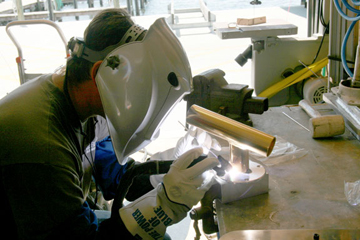
Miller's Blue Lightning™ technology provides welder/fabricators at
Island Welding LLC with consistent arc starts and greater weld puddle
control when welding on the anodized aluminum that is so prevalent
around the Gulf Coast marinas. Here, welder Robert Hall is welding a rod holder.
James Smith has never been a man to sit idle. Thirty years ago he began his welding career in the pipeline, plant fabrication, petrochemical and nuclear industries before transitioning into a teaching career at Jefferson Davis Community College, where he was a Senior Welding Instructor for 16 years. He left teaching only a few years ago to work as a manager for the weld training & testing department for a ship builder in Mobile, Ala., a position he still holds. But that's just the beginning.
After discovering 15 years ago that commercial and private boat owners in the Gulf Coast area couldn't find a company to provide reliable welding repairs on anodized aluminum, Smith created Island Welding, where he and three others put themselves on call, weekends and nights only, to take on emergency (or not so urgent) welding repairs and fabrication jobs. In the process, the company has carved out a niche as the people to call, day or night, especially for the tough anodized aluminum jobs that are so prominent in the marine industry. In fact, anodized aluminum makes up about 80 percent of Island Welding's work.
Along with his employees-Scott Eubanks, Robert Hall and Matt Ferington -Smith knew early on that the key to maintaining the company's niche was finding right equipment to tackle the anodized aluminum jobs with ease, no matter the location or difficulty. In short, he needed equipment with three key features: portability, efficiency and versatility. And after varying degrees of success trying different power sources, Smith finally found exactly what he was looking for with Miller Electric Mfg. Co.'s Dynasty® 200 DX AC/DC Stick/TIG inverter. Even more, the equipment has helped Smith and his team gain benefits that they hadn't expected, including improved productivity and cost savings on everything from electricity to filler rods.
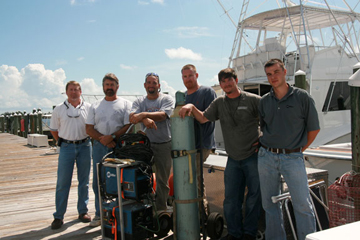
Clay Byron, Miller Electric Mfg. Co; James Smith, Matt Ferington,
Scott Eubanks, Robert Hall of Island Welding; and Miller Electric Mfg. Co.
district manager, Ryan O'Dell.
Anodized Aluminum's Challenge
Often Smith's repair work results from design flaws, loose mounting pads, lack of maintenance and more in an existing tuna tower or T-Top. "Fiberglass and anodized aluminum have different stretch factors and yield strength. We call it the 1-inch rule. If you can flex the top by one inch and no more it will probably be a good job. If it isn't designed to accommodate that, if it's too flexible or too rigid, has too many bends or bends that are too sharp, it will crack."
These cracks are especially difficult to repair on anodized aluminum, but this material is undoubtedly the most prominent around the marina due its corrosion resistance. It is used for tuna towers, rod holders, chairs and t-tops on sport fishing boats, piers, bow rails, wakeboard towers and more. Anodizing converts a standard aluminum surface to one with layers of oxide, which can vary from 0.0002- to 0.001-in. thick. This coating is hard, dense and non-conductive in order to protect the base metal and increase corrosion resistance, a must for high salinity environments. It also offers excellent wear and abrasion properties, along with a wide range of decorative finishes (color varies with the thickness of the coating).
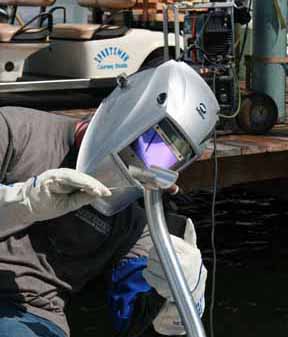
The portability of Island Welding's Dynasty 200 has allowed them to
triple their productivity and meet the repair demands of the Gulf Coast
marinas-right on the spot. Here welder Robert Hall welds a support bracket.
The difficulty in welding anodized aluminum lies in removing the oxide layer without burning through the aluminum base. Aluminum oxide melts at about 3,600 degrees F, while the aluminum underneath melts at about 1,200 degree F. Very few welding operators can develop a technique and find a machine that lets them manipulate the arc so that it penetrates the anodized coating and also establishes a good weld puddle without adding so much heat that the puddle rolls out of the joint or the arc blows through the base metal.
When Smith decided to start Island Welding, he purchased a Miller Trailblazer® welder generator, a high frequency arc starter and stabilizer, and a spool gun to take on these tough repairs. The equipment did a good job, but had one significant limitation: portability. While the trailer that held it could get them close to a needed repair, its size often made it impossible to push do
ext/javascript"> wn the dock. When this problem arose, customers would have to bring the boat to a more convenient location at one of the local marinas. Otherwise, Smith and the rest of the team would have to stretch out their welding leads, which unfortun
ately reduced their available amperage output. The other option, according to Smith, would be to break down the HF box and water cooler and take them to the dock-a process that could take an hour or more to set up
to complete a five-minute weld.
Making the Discovery
The solution to the portability issue Island Welding had been facing was in Smith's hands for some time before he realized it. While teaching at the college, he ordered a Dynasty 200 AC/TIG inverter in order to fix aluminum doorways around the school.
"We didn't touch it for six months," Smith remembers. "We left it in the box until one day when a student and I decided to pull it out and try it. When we started welding with that machine, I saw the potential of it. So I turned around and bought one for myself."
After introducing the Dynasty to the rest of the team at Island Welding, it wasn't long until they all saw the difference that the power source could make-especially in terms of portability. Unlike their trusted Trailblazer, which weighs in at 568 lbs., the Dynasty weighs a mere 45 lbs. and can be easily moved from job to job.
"We fabricated a small aluminum dolly that lets us tote the Dynasty and its water cooler wherever we want around the docks. We also use a second dolly that holds our argon bottle at the end of the dock," explains Smith.
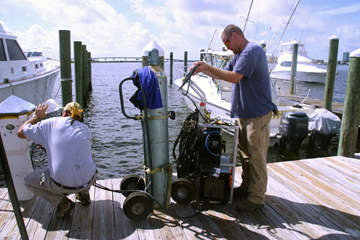
The portability of Miller's Dynasty 200 has helped Island Welding cut
their welding set up time from an hour or more down to 15 to 20 minutes.
The Dynasty also operates off the 220 to 250-volt, 50-amp service found in the area marinas, a feature made possible by Miller's Auto-Line™ Power Management Technology. Auto-Line allows for any input voltage (110 - 460 V) with no manual linking and can accommodate for the unreliable power often found on marina job sites. Smith and the team just plug in the Dynasty's eight ft. primary cord, to which they've added a 50-amp shore power plug, and start welding. The advantage? Smith and his team can set up their Dynasty inverters in 15 or 20 minutes now, compared to an hour or more with the Trailblazer.
With the portability issue solved, the company realized it was in an even better position to meet the demands for anodized aluminum welding in the marina, along with the other odd jobs they receive each week. In fact, they quickly tripled the number of jobs they could do in a given day.
But that's not the whole story. According to Smith, it is easier than ever before to create high quality welds due to the Dynasty's reliable arc starts and because they can now narrow the weld's heat-affected zones. The arc starting capabilities are the result of Miller's exclusive Blue Lightning™ technology. This high frequency arc starter offers non-contact arc initiation that is significantly more consistent than traditional HF arc starters. It also features preset parameters for tungsten sizes from .020 - 1/8 inch, which helps the welders gain the same reliable arc starts regardless of the diameter they use. In the case of Island Welding, they have been able standardize on a pointed 3/32 diameter, 2 percent ceriated tungsten.
"The Dynasty is amazing. It just lights right up," says Smith's crew, of the inverter's arc starting capabilities.
Smith agrees, adding, "In the old days we used to TIG weld [aluminum and anodized aluminum] with an HF box. It was hard to start. It also gave us a very wide weld, along with a wi
de heat-affected zone. With our Dynasty, we can focus the arc and get a lot tighter weld bead."
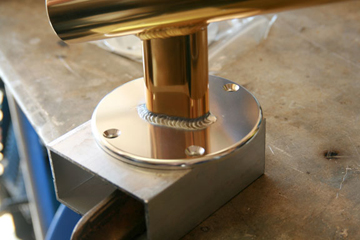
Dynasty 200's adjustable balance control helps welder/fabricators at
Island Welding disrupt less of the anodized material on the aluminum
they repair, and provides for an easier to control weld bead and higher
quality welds, as shown here on this gold anodized rod holder.
Specifically, the welds that the team made with their old technology measured about a half inch wide, whereas with the Dynasty, they have been able to keep their welds around 5/16 or 3/8-inch wide or less-or, 25 to 38 percent narrower. This tighter bead width is the result of the Dynasty's adjustable AC frequency, which is capable of 250 hz and has a narrowing affect on the arc.
The Dynasty 200 also has an adjustable balance control that helps Smith and the team refine their weld bead appearance, along with the option to use one of four adjustable AC waveforms, including: soft squarewave, sine wave, advanced squarewave, and triangular wave, the latter two of which Island Welding uses to gain more peak amperage from the Dynasty. The result, according to Smith, is that he and the team have gained about a 20 percent increase in their travel speeds.
According to Smith, the Dynasty's adjustable balance control also helps them to deal with the nuances of welding anodized aluminum. The Dynasty's extended AC Balance (30 to 99 percent) controls the amount of oxide cleaning or the amperage time in the EP, or electrode positive phase. This feature, in turn, disrupts less of the anodized material on the aluminum and provides for an easier to control weld bead and higher quality weld.
Smith agrees, explaining, "With our Dynasty, our welds went from looking like everyone else's to looking like they were done with an orbital welder. People who never noticed welds before began complimenting us."
The Rest of the Story
If finding the solution to a long standing portability issue and tripling productivity isn't enough, Smith says that the company has also realized significant savings in fuel, power, filler metal, shielding gas combined-all of this from a 45-lb. blue box that Smith says "...is so small, it looks like it could have been made by a toy company."
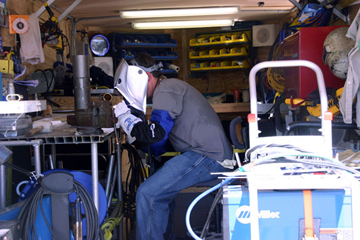
Miller's Dynasty 200 offers welder/fabricators at Island Welding the
flexibility to weld at the marina, in the shop and, as shown here,
in the company's trailer that they use to carry equipment to jobs around
the Gulf Coast. Here Robert Hall is welding.
According to Smith, because they can plug into the primary power around the marina, it saves them about 40 percent in fuel for powering up the Trailblazer on a regular basis. Before, they went through about 12 gallons of fuel a weekend, compared to the four or five that they now use. Plus, they use less argon with the Dynasty than they did with their old welder. With the Dynasty's faster travel speeds and narrower weld bead, Smith and the other welders need less filler rods to complete the welds. In fact, Smith figures that they have gone from spending approximately $2,300 a year on filler rods to around $1,000-a 43 percent savings.
So what is the total effect of all of these benefits for Island Welding ?
"To make a long story short," says Smith, "If you took the Dynasty away from me, I would quit welding. Bottom line."
The other bottom line? With this new equipment, Island Welding can save more money, be more productive and service more customers on the Alabama Gulf Coast area-all benefits that came out of a simple quest for a more portable machine.